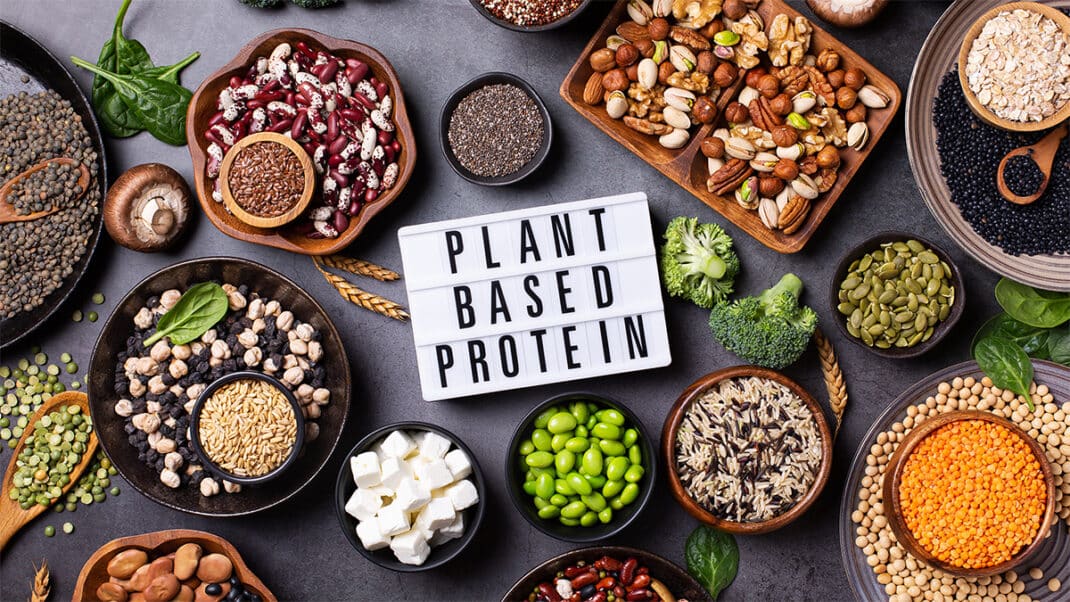Protein Intake and Timing
Researchers find we're eating too much protein at the wrong times—and not enough at the right times.

Protein intake and timing are perennially hot topics. Carbs have been demonized. Fat has been on the chopping block. But protein? It earns a health halo, often connected to everything from weight loss to muscle gains. Maybe this is for good reason. After all, researchers and protein experts around the world are investigating protein’s optimal role in aging and satiety across the lifespan. Yet that doesn’t mean our diets get protein right. Researchers find we’re eating too much protein at the wrong times—and not enough at the right times. Namely, we need more high-quality protein intake at breakfast and less protein at dinner, the research suggests (Mamerow et al. 2014).
Protein: How Much Is Enough?
Nutrition experts recommend that protein accounts for 10%–35% of all the calories we eat daily (IOM 2002). How are we doing with that recommendation? A paper published in the American Journal of Clinical Nutrition found that, on average, men and women up to age 70 get about 15% of total calories from protein. While that is within the 10%–35% recommendation, the author of the paper suggests boosting the minimum to 25%, “given the positive benefits of higher protein intake on satiety and other physiologic functions” (Fulgoni 2008).
Examining diet in more depth exposes us to a raft of acronyms representing how much of specific nutrients the experts say we should consume. For instance, the Institute of Medicine has several DRIs (dietary reference intakes) for protein:
- RDA (recommended dietary allowance)
- EAR (estimated average requirement)
- AI (adequate intake)
All these DRIs are based on nitrogen balance studies, under conditions of energy balance (DGAC 2010; Rodriguez 2015).
The most familiar of these acronyms is the RDA—which for protein is 0.8 gram per kilogram of body weight for adults 19 and older. Protein experts like Stewart Phillips, PhD, FACSM, FACN, professor at McMaster University, suggest this level can be misleading.
“That level of protein—0.8 g/kg/d or the RDA—is the minimal level of protein to offset negative nitrogen balance in 98% of individuals. The RDA is really, in my opinion, the MDI—minimal dietary intake. Thus, nothing about that level should be recommended, and you’re allowed to eat much more. In fact, for older persons and athletes, there are benefits to consuming protein at levels above the RDA.”
See also: Protein Overload: Are You Eating More Than You Need?
Protein Intake and Timing
Recently, protein research has moved beyond investigating the optimal amount of protein to eat and has examined the optimal times to eat it. Nutrition researchers have found that most Western diets skew protein intake toward the evening meal—breakfast is typically carbohydrate-rich and protein-poor, while the evening meal is often much higher in protein and calories (Mamerow et al. 2014).
In keeping with this, some of the National Institutes of Health and Nutrition Examination Survey (NHANES) data on protein consumption in the U.S. demonstrates that men typically consume about 15 g of protein at breakfast, while women consume about 10 g (Rains et al. 2013). It’s also important to note that only about 40% of Americans actually eat breakfast. Thus, not only are many Americans consuming low-protein breakfasts, but the majority are not consuming any protein at all. And there is increasing evidence of a causal link between breakfast skipping and obesity (Ma et al. 2003).
See also: Build a Better Breakfast
This unbalanced intake doesn’t quite give the hard-working muscles what they need, nor does it do the job of helping curb appetite throughout the day. “Unlike [with] fat or carbohydrate, the body has limited capacity to store excess dietary protein/amino acids from a single meal and use them to stimulate muscle growth at a later time,” says Douglas Paddon-Jones, PhD, professor at the University of Texas Medical Branch and a leading protein researcher. “In other words, your large salmon dinner tonight is probably not going to influence muscle growth at lunch tomorrow.”
His research and that of other experts suggest it is best to distribute protein intake evenly throughout the day, starting with breakfast. “It makes perfect sense,” says Phillips. “You’ve just gone 10 hours without food [and] your muscles are catabolic. Protein at breakfast gives your muscles their first chance to rebuild after you’ve slept. It’s a good idea to aim for around 20 g of protein if you’re younger or 30–40 g if you’re older, to give your muscle its best chance to rebuild, since these doses of protein are at the top end of what your muscles need.”
This balanced concept suggests that a moderate amount of high-quality protein three times per day may be better than the typical Western diet with too much protein at dinnertime and not enough at breakfast. The balanced protein distribution concept isn’t just about muscle growth and repair, though. It has the potential to affect many health outcomes, such as blood sugar control, moderate calorie intake and satiety (being full) (Leidy et al. 2015).
Protein Intake and Satiety
Let’s explore the benefit of satiety. Of course, being more full may affect how much a person eats. If you eat less because you’re already feeling full, theoretically that could help with weight loss.
Heather Leidy, PhD, an assistant professor at the University of Missouri, has done a lot of the work on protein and satiety. Her group recently completed a 12-week, long-term randomized controlled trial study comparing the effect of eating a normal-protein vs. a high-protein breakfast in those who had habitually skipped the morning meal (Leidy et al. 2015).
This study illustrated that those who added a high-protein breakfast containing 35 g of protein every day for 12 weeks prevented gains in body fat compared with those who continued to skip breakfast. In contrast, eating a normal-protein breakfast did not prevent fat gains. In addition, only the high-protein breakfast reduced daily hunger and led to voluntary reductions of about 400 calories in daily food intake. “These data suggest that a simple dietary strategy of eating a protein-packed breakfast can improve weight management,” Leidy said.
See also: Plant Protein for Muscle Growth
Protein Quality Matters
When we’re talking “protein-packed breakfast,” quality certainly matters. While there’s no formal definition for “high-quality” protein, there are many ways to determine dietary protein quality. Generally speaking, complete proteins that provide all the essential amino acids are considered “high quality.” These include foods like eggs, fish, beef, poultry, dairy (including milk, cottage cheese, Greek yogurt, whey protein and others) and soy. However, one amino acid—leucine—seems to stand head and shoulders above all others.
Leucine: Is It Protein’s Magic Bullet?
One commonality of the foods I just mentioned is that they are all good sources of the amino acid leucine. What is leucine, and why does it matter?
Protein is made up of amino acids. Among the 20 amino acids, nine are considered essential amino acids, meaning we need to get them from food because our body doesn’t make them. Of those nine amino acids, three are called branched-chain amino acids, one of which is leucine.
Leucine is particularly interesting because its concentration in a protein ultimately determines the optimal amount of protein per meal. Leucine is the “rate-limiting” amino acid in muscle protein synthesis (building and maintaining muscle). Further, proteins with more (vs. less) leucine do a better job of stimulating muscle protein synthesis (Layman et al. 2015 ).
One hypothesis is that we have a “leucine threshold” where protein with higher (vs. lower) leucine quantities becomes more effective at stimulating muscle protein synthesis (Phillips 2014). More specifically, data and consensus show that each meal needs 2.2–3.0 g of leucine to maximize muscle protein synthesis (Layman et al. 2015; Bauer et al. 2013).
These numbers are critical because research suggests if a meal has less than 2.0 g of leucine, the protein will be burned for energy instead of being used for muscle protein synthesis. This brings us back to protein quality, not just quantity (Norton et al. 2012).
Measuring Leucine Content in Foods
While it is easy to get the recommended amount of leucine (2.2–3.0 g) with protein supplements, real food works, too—sometimes even better. As you see in Table 1, cottage cheese is one of the highest food sources of leucine, providing 2.9 g per cup (about 28 g of protein). Some others are listed as well.
Meeting Daily Protein Needs
The key to remember is that protein intake is not just about quantity; it’s about the frequency and quality of the protein we eat. A goal of eating 2.2–3.0 g of leucine in each meal to maximize protein synthesis can go a long way to support the benefits of protein.
Translating Research Into Results
While it is important to discuss specifics about protein quantity, timing and quality, at the end of the day what does this mean for your clients?
Educate them about eating high-quality protein options in the morning—not to the exclusion of other foods, but rather as a complement to balance their plate. Urge them to eat one palm-sized portion of quality protein at each meal (depending on the size of the person’s hands, this will provide approximately 20–30 g of protein). And encourage them to decrease their portion of protein in the evening, when most are eating significantly more than their bodies can benefit from.
References
Bauer, J., et al. 2013. Evidence-based recommendations for optimal dietary protein in older people: A position paper from the PROT-AGE Study Group. Journal of the American Medical Directors Association, 14 (8), 542-59.
DGAC (Dietary Guidelines Advisory Committee). 2010. Report of the Dietary Guidelines Advisory Committee on the Dietary Guidelines for Americans, 2010, to the Secretary of Agriculture and the Secretary of Health and Human Services. Accessed Oct. 13, 2015. www.nutriwatch.org/05Guidelines/dga_advisory_2010.pdf.
Fulgoni, V.L. 2008. Current protein intake in America: Analysis of the National Health and Nutrition Examination Survey, 2003-2004. American Journal of Clinical Nutrition, 87 (5), 1554S-57S.
IOM (Institute of Medicine). 2002. Dietary reference intakes for energy, carbohydrate, fiber, fatty acids, cholesterol, protein, and amino acids. Accessed Oct. 23, 2015. iom.nationalacademies.org/Reports/2002/Dietary-Reference-Intakes-for-Energy-Carbohydrate-Fiber-Fatty-Acids-Cholesterol-Protein-Amino-Acids.aspx.
Layman, D.K., et al. 2015. Defining meal requirements for protein to optimize metabolic roles of amino acids. American Journal of Clinical Nutrition, 101 (6), 1330S-38S.
Leidy, H.J., et al. 2015. A high-protein breakfast pre- vents body fat gain, through reductions in daily intake and hunger, in “breakfast skipping” adoles- cents. Obesity, 23 (9), 1761-64.
Ma, Y., et al. 2003. Association between eating patterns and obesity in a free-living US adult population. American Journal of Epidemiology, 158 (1), 85-92.
Mamerow, M.M., et al. 2014. Dietary protein distribution positively influences 24-h muscle protein synthesis in healthy adults. The Journal of Nutrition, 144 (6), 876-80.
Norton, L.E., et al. 2012. Leucine content of dietary proteins is a determinant of postprandial skeletal muscle protein synthesis in adult rats. Nutrition and Metabolism, 9, 67.
Phillips, S.M. 2014. A brief review of critical processes in exercise-induced muscular hypertrophy. Sports Medicine, 44 (Suppl. 1), S71-77.
Rains, T.M., et al. 2013. Protein intake at breakfast is associated with reduced energy intake at lunch: An analysis of NHANES 2003-2006. FASEB Journal, 27, 349.7.
Rodriguez, N.R., et al. 2015. Introduction to Protein Summit 2.0: Continued exploration of the impact of high-quality protein on optimal health. American Journal of Clinical Nutrition, 101 (Suppl.), 1317S-19S.





